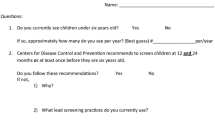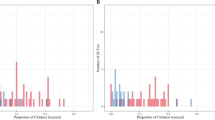Abstract
This article presents information on pregnant women with incident blood lead levels (BLLs) of 20 μg per deciliter or greater as reported to the New York City Department of Health between September 1996 and June 1999 (n=33). Almost half of the women were diagnosed during their third trimester of pregnancy, often at their first prenatal visit. The median BLLs at incidence and at last report among women who were retested were 25 and 15 γ/dL, respectively, a 40% decline. The median incident BLL among newborns (n=25) was 12 μg/dL. The BLLs were inversely associated with maternal age and length of time in the United States and directly associated with gestational age and pica behavior. Cases were more than twice as likely to be foreign-born women than all women who gave birth in New York City. Prenatal care facilities employing a policy of universal blood lead testing of all pregnant women at the time of their first visit reported disproportionate numbers of cases, accounting for 77% of cases yet only 11% of all births citywide. The findings suggest that (1) the promulgation of recent rules and guidelines for lead risk assessment and screening among pregnant women appears to have been effective in identifying cases that might not have otherwise come to light; (2) case management and environmental interventions were initiated promptly; (3) cases experienced, on average, significant BLL reductions over time; and (4) there is a need for additional public health interventions for pregnant women in urban, multicultural centers. While the data suggest that universal screening may increase case finding among high-risk, immigrant populations, further studies and surveillance are needed to determine systematically the most effective approach.
Similar content being viewed by others
References
US Centers for Disease Control and Prevention. Update: blood lead levels—United States, 1991–1994. MMWR Morb Mortal Wkly Rep. 1997;46(7):141–146.
US Centers for Disease Control and Prevention. Blood lead levels in young children—United States and selected states, 1996–1999. MMWR Morb Mortal Wkly Rep. 2000; 49(50):1133–1137.
US Centers for Disease Control. Preventing Lead Poisoning in Young Children. Atlanta, GA: Agency for Toxic Substances and Disease Registry, US Dept of Health and Human Services, Public Health Service; 1991.
Lanphear BP, Dietrich K, Auinger P, Cox C. Cognitive deficits associated with blood lead concentrations <10 μg/dL in US children and adolescents. Public Health Rep. 2000; 115(6):521–529.
US Centers for Disease Control. Agency for Toxic Substances and Disease Registry. Toxicological Profile for Lead (Update). Atlanta, GA: Agency for Toxic Substances and Disease Registry, US Dept of Health and Human Services, Public Health Service; July 1999.
US Department of Labor, Occupational Health, and Safety Administration. Final Standard for Occupational Exposure to Lead. Washington, DC: US Dept of Labor, Occupational Health, and Safety Administration; 1978. 29 CFR 1910.1025.
US Department of Labor, Occupational Safety, and Health Administration. Lead in Construction, Interim Final Rule. Washington, DC: US Dept of Labor, Occupational Health, and Safety Administration; 1993. 29 CFR 1926.62.
Title X, Residential Lead Poisoning Control Act of 1992. 42 USC §63.
Lancranjan I, Popescu HI, Gavanescu O, et al. Reproductive ability of workmen occupationally exposed to lead. Arch Environ Health. 1975;30(8):396–401.
Min YI, Correa-Villasenor A, Stewart PA. Parental occupational lead exposure and low birth weight. Am J Ind Med. 1996;30(5):569–578.
Nordstrom S, Beckman L, Nordensen I. Occupational and environmental risks in and around a smelter in northern Sweden: V. Spontaneous abortion among female employees and decreased birth weight in their offspring. Hereditas. 1979;90(2):291–296.
Baghurst PA, Robertson EF, Michael AJ, et al. The Port Pirie cohort study: lead effects on pregnancy outcome and early childhood development. Neurotoxicology. 1987;8(3):395–401.
Hu H, Pepper L, Goldman R. Effect of repeated occupational exposure to lead, cessation of exposure and chelation on levels of lead in bone. Am J Ind Med. 1991;20(6):723–735.
McMichael AJ, Baghurst PA, Wigg NR, Vimpani GV, Robertson EF, Roberts RJ. Port Pirie cohort study: environmental exposure to lead and children’s abilities at the age of 4 years. N Engl J Med. 1988;319(8):468–476.
Crocetti AF, Mushak P, Schwartz J. Determination of numbers of lead-exposed women of childbearing age and pregnant women: an integrated summary of a report to the US Congress on childhood lead poisoning. Environ Health Perspect. 1990;89:121–124.
Flanigan GD, Mayfield R, Blumenthal HT. Studies on lead exposure in patients of a neighborhood health center: Part II. A comparison of women of childbearing age and children. J Natl Med Assoc. 1992;84(1):23–27.
Fletcher AM, Gelberg KH, Marshall EG. Reasons for testing and exposure sources among women of childbearing age with moderate blood lead levels. J Community Health. 1999;24(3):215–227.
State of New York. Lead Poisoning Prevention and Control. Pub Hlth L 10 NYCCR §206(1)(n) Part 67. Available at: http://www.health.state.ny.us/nysdoh/phforum/nycrr 10. htm. Accessed on January 10, 2001.
New York State Department of Health and American College of Obstetricians and Gynecologists District II. Lead Poisoning Prevention Guidelines for Prenatal Care Providers. Albany, NY: State of New York, Dept of Health; December 1995.
New York City Department of Health. Birth File 1996–1999 [computer file]. New York, NY: New York City Dept of Health, Office of Vital Statistics; 2001.
New York City Department of Health. Summary of Vital Statistics 1997 and 1998 [database online]. 2000. Available at: http://www.nyc.gov/html/doh/html/pub/pub.html. Accessed on January 20, 2001.
Edwards CH, Johnson AA, Knight EM, et al. Pica in an urban environment. J Nutr. 1994;124(6suppl):954S-962S.
Simpson E, Mull DJ, Longley E. Pica during pregnancy in low-income women born in Mexico. West J Med. 2000;173:20–24.
Rothenberg SJ, Manalo M, Jiang J, et al. Maternal blood lead level during pregnancy in South Central Los Angeles. Arch Environ Health. 1999;54(3):151–157.
US Centers for Disease Control and Prevention. Adult blood lead epidemiology and surveillance—United States, second and third quarters, 1998, and annual 1994–1997. MMWR Morb Mortal Wkly Rep. 1999;48(10):213–216, 223.
US Census Bureau. Current Population Survey. March 1997. Available at: http://www. census.gov. Accessed on January 13, 2001.
Rothenberg SJ, Darchmer S, Schnaas L, Perroni E, Zea F, Fernández Alba J. Changes in serial blood lead levels during pregnancy. Environ Health Perspect. 1994;102(10): 151–60.
Hernandez-Avila M, Gonzalez-Cossio T, Palazuelos E, et al. Dietary and environmental determinants of blood and bone lead levels in lactating postpartum women living in Mexico City. Environ Health Perspect. 1996;104(10):1076–1082.
Hu H, Hashimoto D, Besser M. Levels of lead in blood and bone in women giving birth in a Boston hospital. Arch Environ Health. 1996;51:52–58.
Gulson BL, Jameson CW, Mahaffey KR, Mizon KJ, Korsch MJ, Vimpani G. Pregnancy increases mobilization of lead from maternal skeleton. J Lab Clin Med. 1997;130:51–62.
Hertz-Picciotto I, Schramm M, Watt-Morse M, Chantala K, Anderson J, Osterloh J. Patterns and determinants of blood lead during pregnancy. Am J Epidemiol. 2000; 152(9):829–837.
Hernandez-Avila M, Romieu I, Rios C, Riverro A, Palazuelos E. Lead-glazed ceramics as a major determinant of blood lead levels in Mexican women. Environ Health Perspect. 1991;94:117–120.
Matte TD, Proops D, Palazuelos E, Graef J, Hernandez-Avila M. Acute high-dose lead exposure from beverage contaminated by traditional Mexican pottery. Lancet. 1994; 344:1064–1065.
Decreasing childhood lead poisoning in New York City, 1970–1998. J Urban Health. 1999;76(4):545.
40 CFR Part 745, Residential Lead Hazard Standards.
Author information
Authors and Affiliations
Corresponding author
Additional information
All authors were affiliated with the New York City Department of Health at the time of their work on this project.
Rights and permissions
About this article
Cite this article
Klitzman, S., Sharma, A., Nicaj, L. et al. Lead poisoning among pregnant women in New York City: Risk factors and screening practices. J Urban Health 79, 225–237 (2002). https://doi.org/10.1093/jurban/79.2.225
Issue Date:
DOI: https://doi.org/10.1093/jurban/79.2.225




